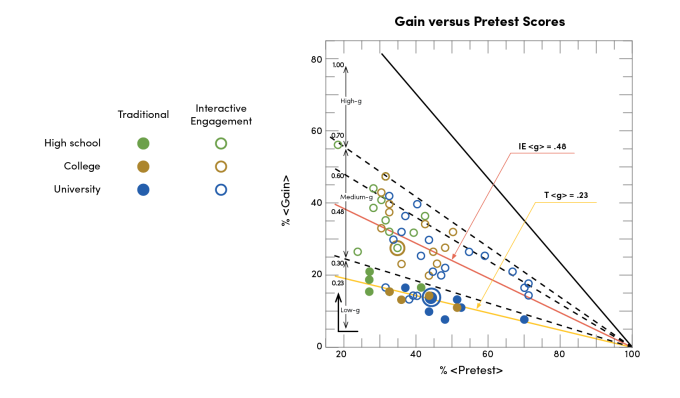Evidence of Active Learning's Effectiveness
Engaging students to create meaning, develop cognitively complex skills and take ownership of their learning.
On this page:
Traditional lectures are efficient at delivering information, especially for large courses with limited teaching support. Lectures, however, are often inefficient at engaging students to create meaning, especially at higher levels of cognition. Lectures focus on the transmission of information to students who then become passive receivers. Consequently, it becomes unclear what students should do once they have received information, and there is a lack of knowing whether students have understood what was received. Further, many higher order cognitive skills such as analyzing, evaluating, and creating require students to practice doing something, and only by actively working with content will students begin to understand their own learning.
While there are several reasons why lectures are not an ideal teaching method, the overall challenge is that students often require support when they are working with new content or concepts. This is best done during class, by integrating expert guidance, like scaffolding, to help students actively and efficiently build knowledge.
Evidence that active learning is more effective than lecture dates back more than twenty-five years (Bonwell, 1991). One of the largest studies comparing active learner-centered classes and traditional classes observed 6,542 physics students from 62 introductory courses (Hake, 1998). Hake found that courses with no interactive engagement had average normalized student gains of .23 while courses with active learning had average student gains of .48 (almost two standard deviations above traditional scores).
Fig. 1. This figure (Hake, 1998) graphically compares student performance in courses with interactive engagement versus traditional courses and shows significantly larger learning gains for courses with interactive engagement relative to traditional courses.
Further, and what’s perhaps most telling from this chart (Fig. 1), is that the worst interactive engagement courses (e.g., the lowest open circles) did better than almost all traditional courses (e.g., the highest solid circles).
A meta-analysis of 225 studies comparing active learning versus lecture-centered course designs in STEM (Science, Technology, Engineering and Math) disciplines found that students in traditional lectures were 1.5 times more likely to fail than students in courses with active learning (Freeman et al., 2014). Moreover, Freeman and colleagues found that student performance on exams, concept inventories and other assessments increased by about half a standard deviation when some active learning was included in course design. These results were found across STEM disciplines.
Another review (Michael, 2006) examined evidence of student-centered active learning approaches from a variety of disciplines such as cognitive and educational psychology. Michael found support for learner-centered instruction and that learning involves the active construction of meaning by the learner. He also found that individuals are likely to learn more when they learn with others and that meaningful learning is facilitated by students needing to articulate explanations to their peers. This sharing of information, which happens in learner-centered environments, allows students to better understand and actively construct what they believe to convey their thinking to others.
- Bonwell, C. C. (1991). Active learning: creating excitement in the classroom. The George Washington University, ERIC Clearinghouse on Higher Education. Washington, D.C.: ERIC Clearinghouse on Higher Education. Retrieved from Retrieved from http://eric.ed.gov/?id=ED336049
- Freeman, S., Eddy, S. L., McDonough, M., Smith, M. K., Okoroafor, N., Jordt, H., & Wenderoth, M. P. (2014). Active learning increases student performance in science, engineering, and mathematics. Proceedings of the National Academy of Sciences, 111(23), 8410–8415. https://doi.org/10.1073/pnas.1319030111
- Hake, R. R. (1998). Interactive-engagement versus traditional methods: A six-thousand-student survey of mechanics test data for introductory physics courses. American journal of Physics, 66(1), 64-74.
- Michael, J. (2006). Where's the evidence that active learning works? Advances in physiology education, 30(4), 159-167.
